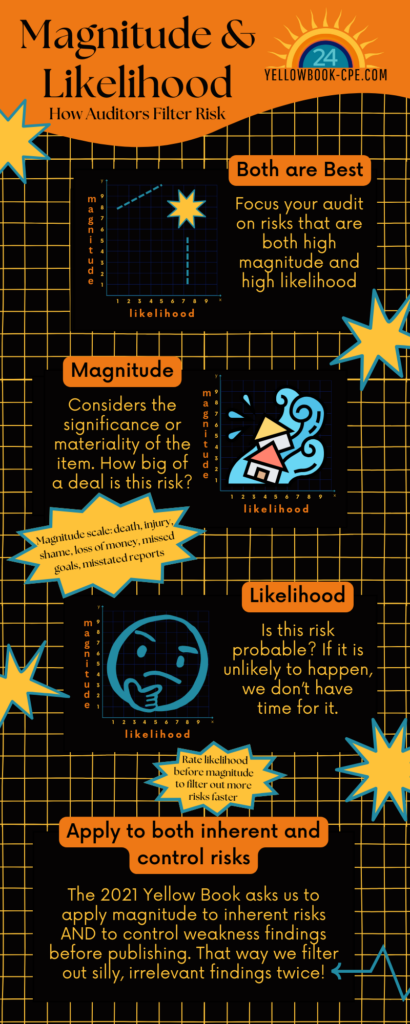Magnitude & Likelihood
Risk assessment per the Green Book is a complicated, multiple-step process. First, you must break it down into small enough pieces to confidently assess the risk on each piece. If your subject matter is too broad, you will have a difficult time moving on to later steps. Next, you must imagine the bad things that could possibly happen with each piece and rank them for magnitude and likelihood.
Both are best
Focus your audit on risks that are both high magnitude and high likelihood.
Magnitude
Considers the significance or materiality of the item. How big of a deal is this risk? The magnitude scale includes death, injury, shame, loss of money, missed goals and misstated reports.
Likelihood
Is this risk probable? If it is unlikely to happen, we don’t have time for it. Rate likelihood before magnitude to filter out more risks faster.
Apply to both inherent and control risks
The 2021 Yellow Book asks us to apply magnitude to inherent risks AND to control weakness findings before publishing. That way we filter out silly, irrelevant findings twice!
Want to learn more?
Then you’re in the right place! I invite you to join me for one of my most popular classes, the Virtual Audit Bootcamp scheduled for June 3-7. In this series of five ½-day webinars for a total of 20 CPE hours, we will explore each phase of conducting a government audit while learning how to comply with significant Yellow Book and IIA standards. And there’s a bonus! Develop your interviewing skills and earn 7 extra hours of CPE at your own pace with a complimentary self-study course, Interviewing Skills for Auditors.


 Yellowbook-CPE.com is registered with the National Association of State Boards of Accountancy (NASBA) as a sponsor of continuing professional education on the National Registry of CPE Sponsors. State boards of accountancy have final authority on the acceptance of individual courses for CPE credit. Complaints regarding registered sponsors may be submitted to the National Registry of CPE Sponsors through its website:
Yellowbook-CPE.com is registered with the National Association of State Boards of Accountancy (NASBA) as a sponsor of continuing professional education on the National Registry of CPE Sponsors. State boards of accountancy have final authority on the acceptance of individual courses for CPE credit. Complaints regarding registered sponsors may be submitted to the National Registry of CPE Sponsors through its website: